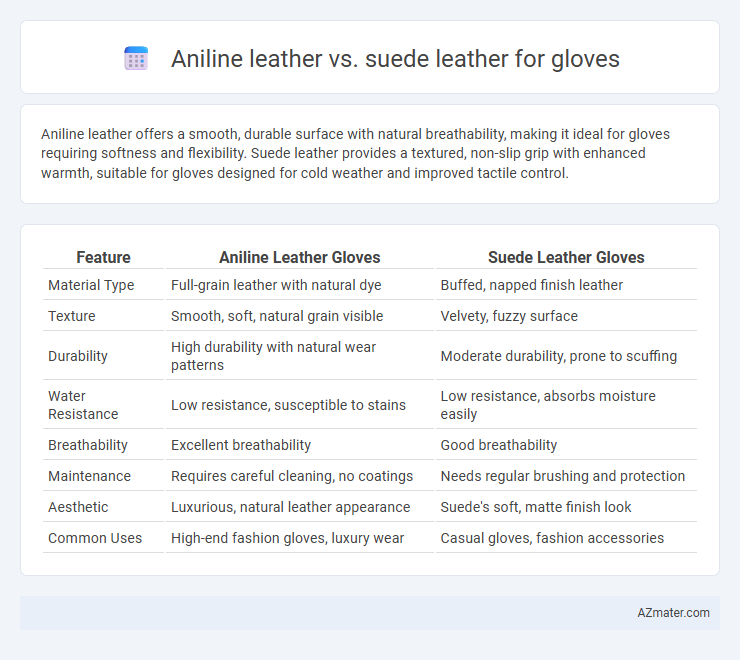Aniline leather offers a smooth, durable surface with natural breathability, making it ideal for gloves requiring softness and flexibility. Suede leather provides a textured, non-slip grip with enhanced warmth, suitable for gloves designed for cold weather and improved tactile control.
Table of Comparison
| Feature | Aniline Leather Gloves | Suede Leather Gloves |
|---|---|---|
| Material Type | Full-grain leather with natural dye | Buffed, napped finish leather |
| Texture | Smooth, soft, natural grain visible | Velvety, fuzzy surface |
| Durability | High durability with natural wear patterns | Moderate durability, prone to scuffing |
| Water Resistance | Low resistance, susceptible to stains | Low resistance, absorbs moisture easily |
| Breathability | Excellent breathability | Good breathability |
| Maintenance | Requires careful cleaning, no coatings | Needs regular brushing and protection |
| Aesthetic | Luxurious, natural leather appearance | Suede's soft, matte finish look |
| Common Uses | High-end fashion gloves, luxury wear | Casual gloves, fashion accessories |
Understanding Aniline Leather: Features and Qualities
Aniline leather for gloves is characterized by its natural, soft texture and rich color derived from pure dyeing without surface coatings, allowing the leather's natural grain and markings to show through. This type of leather offers high breathability and flexibility, making it comfortable for extended wear, but it requires careful maintenance due to its susceptibility to stains and scratches. In contrast, suede leather features a napped finish created by buffing the inner surface, providing a velvety texture that is less water-resistant and easier to mark than aniline but often preferred for its distinct look and tactile feel.
Introduction to Suede Leather: Texture and Composition
Suede leather, derived from the underside of animal hides, features a soft, napped texture achieved by buffing the inner surface of split leather. Its open fiber structure provides a delicate, pliable feel, making it ideal for gloves requiring flexibility and breathability. Compared to the smooth, translucent finish of aniline leather, suede offers a distinct tactile sensation and a matte appearance favored for both comfort and style.
Durability: Aniline vs Suede Leather Gloves
Aniline leather gloves offer superior durability compared to suede leather gloves due to their full-grain hide, which retains the natural surface and resists wear and tear more effectively. Suede leather gloves, made from the inner split of the hide, are softer but more prone to abrasion, staining, and water damage, reducing their lifespan under heavy use. For long-lasting glove performance in demanding conditions, aniline leather is the preferred choice.
Comfort and Breathability Comparison
Aniline leather gloves offer superior breathability due to their minimally treated, natural fiber structure, allowing moisture and air to pass through and providing enhanced comfort during extended wear. Suede leather gloves feature a napped surface that is softer to the touch but generally less breathable than aniline leather, potentially causing more heat retention and reduced comfort in warm conditions. For optimal comfort and breathability in gloves, aniline leather is preferred for its natural permeability, while suede excels in softness but may compromise ventilation.
Visual Appeal: Color, Finish, and Aesthetics
Aniline leather gloves offer a rich, natural color with a smooth, transparent finish that showcases the full grain, highlighting unique markings and providing a luxurious, sophisticated look. Suede leather gloves feature a soft, matte texture with a muted color palette, delivering a plush, velvety aesthetic that exudes casual elegance and warmth. The visual appeal of aniline leather emphasizes depth and authenticity, while suede emphasizes softness and understated style.
Maintenance and Cleaning Requirements
Aniline leather gloves require careful maintenance due to their untreated surface, which absorbs oils and stains easily, necessitating gentle cleaning with specialized leather cleaners and moisturizers to preserve softness. Suede leather gloves demand regular brushing to remove dirt and prevent matting, along with occasional use of suede erasers and waterproof sprays to maintain texture and protect against moisture damage. Both types benefit from prompt stain treatment and avoidance of excessive water exposure to ensure durability and appearance.
Water Resistance and Stain Protection
Aniline leather gloves offer limited water resistance and stain protection due to their untreated, natural surface that absorbs moisture and stains easily. Suede leather gloves are more prone to water damage and staining because the napped finish increases surface area and absorbency, making them less durable against liquids. Both types require specialized waterproofing sprays to enhance durability, but aniline leather maintains a smoother finish compared to the textured, delicate surface of suede.
Price Differences and Cost Efficiency
Aniline leather gloves typically command higher prices due to their premium full-grain quality and natural finish, which maintains the hide's original texture and breathability. Suede leather gloves are generally more cost-efficient, offering a softer, napped surface at a lower price point but with less durability and water resistance compared to aniline leather. When considering long-term investment, aniline leather gloves provide enhanced durability and aging appeal, justifying their higher initial cost over suede alternatives.
Best Use Cases for Each Leather Type
Aniline leather gloves offer a smooth, natural finish with high breathability, making them ideal for formal wear and drivers seeking elegance and comfort. Suede leather gloves provide a soft, textured grip and enhanced durability, perfect for outdoor activities and casual use where warmth and resistance to wear are essential. Choosing between aniline and suede depends on the need for refined appearance versus practical functionality.
Choosing the Right Leather Gloves: Aniline or Suede?
Aniline leather gloves offer a smooth, natural finish with excellent breathability and a soft, supple feel, making them ideal for luxurious comfort and flexibility. Suede leather gloves provide a textured surface with enhanced grip and durability, suitable for activities requiring better traction and sturdiness. Choosing between aniline and suede gloves depends on the balance of elegance versus functionality desired for specific uses.

Infographic: Aniline leather vs Suede leather for Glove
 azmater.com
azmater.com